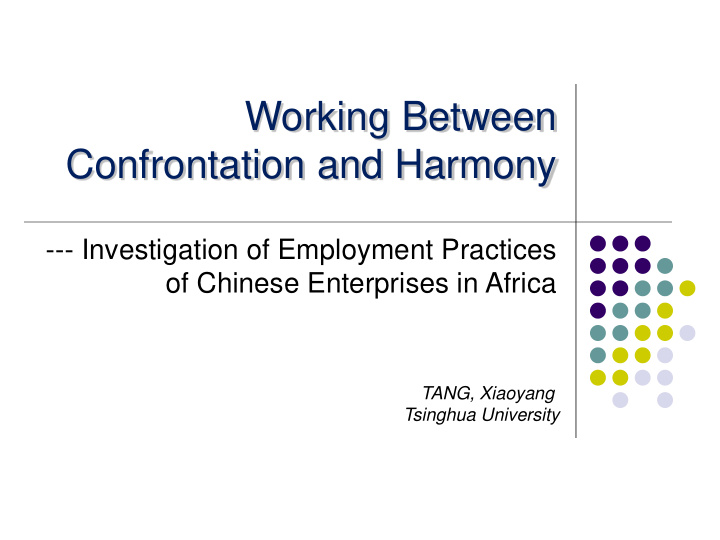



Working Between Confrontation and Harmony --- Investigation of Employment Practices of Chinese Enterprises in Africa TANG, Xiaoyang Tsinghua University
Background Rapid growth of Chinese economic activities in Africa 12000 140000 120000 10000 100000 8000 80000 FDI stocks 6000 Trade 60000 In $ million 4000 40000 2000 20000 0 0 2003 2004 2005 2006 2007 2008 2009 2010 Source: MOFCOM of P.R.C.
Background Areas of Investment • Construction • Energy • Mining • Manufacturing • Telecom • Agriculture • Service
Employment Topics • Influx of Chinese Workers? • Low Wages? • Poor working conditions? • Hard work? • Disciplines?
Influx of Chinese Workers? State of Local Employment • Various ratios of local worker by sectors 90.00% 90.00% Agriculture Agriculture Hydropower Hydropower 80.00% 80.00% Municipal Municipal Construction Construction 70.00% 70.00% Commercial Housing Commercial Housing 60.00% 60.00% Telecommunication Telecommunication Catering Catering 50.00% 50.00% Trading Trading 40.00% 40.00% Manufacturing Manufacturing 30.00% 30.00% 20.00% 20.00% Source: The Ministry of Finance of Angola, June 30. 2007 10.00% 10.00% 0.00% 0.00% Local Employment % Local Employment %
No. of No. of Tenant Tenant Tenants: Tenants: Com- Com - Approx. # Approx. # panies panies (in of Chinese of African (signed) oper- ation) workers Workers Egypt TEDA 49 38 103 1102 Zambia Chambish 36 26 1372 7973 Nigeria Lekki 26 6 50 400 Mauritius Jinfei n/a 0 n/a n/a Nigeria Ogun 34 7 177 1619 Ethiopia Eastern 12 6 300 1600 Source: Field research
a large number of Chinese workers have come to Africa recently. Source:MOFCOM
employment of local workers is both encouraged by governments and motivated by economic calculation (reduce labor costs) early reliance on Chinese employees related to Chinese companies’ labor intensive business models. short term need and long term trend
Low Wages? No clear unambiguous answer Case study: two Chinese tanneries in Ethiopia
Low Wages? Quick return vs. long term investment Low wages first and increasing pay incrementally Chinese perspective vs. African perspective? Employer perspective vs. employee perspective?
Poor working conditions? Investment first and enjoyment later: “ eat bitterness” and African acceptance
Divergent views on working and living conditions e.g. labor protection and safety issues in mining 3 accidents/week vs. 1 accident/month
Hard work ? stereotypical perception of Chinese work ethics and African characteristics • “the Chinese do not rest;” “their work cannot be done by human beings;” • “slow”, “inefficient”, “backward,” or simply “lazy.” • learn spirit of hard work
Questions What makes up hard work? Overtime? Heavy load?
Disciplined Organization ? Punctuality “Late arrival is delay, early arrival is waste, punctuality is integrity.”
Authority and Paternalism “100% cooperation, 100% understanding, 100% implementation and 100% obedience”
Conclusion Capitalist Logic pursuit of profit, and forever renewed profit, by means of continuous, rational, capitalistic enterprise – Max Weber Industrialization transforms traditional society Adaptation and Social Integration capitalism with Chinese characteristics vs. capitalism with African characteristics tangxyang@gmail.com
Recommend
More recommend